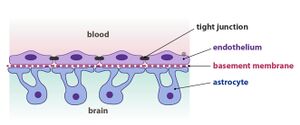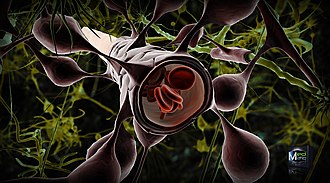Blood-brain barrier
The blood-brain barrier (in the narrower sense) creates a transition between brain capillaries and brain tissue . The morphological basis of the blood-brain barrier is a continuous layer of cerebral capillary endothelium on the blood side, a basement membrane and a layer of astrocytes on the brain side . Brain capillary endothelium differs from endothelium in other locations in that it is free of fenestrations and endothelial cells are connected by tight junction . Astrocyte protrusions are attached to the basement membrane together with pericytes ( microglial cells ) (Fig. 1).
The transfer of substances from the blood to the brain takes place on the basis of their fat solubility or by means of carrier systems. Water and substances readily soluble in lipids (eg ethanol, nicotine , gases - O2, CO2, N2O)) pass easily. The necessary hydrophilic substances are transported to the brain using specific transport systems ( glucose , neutral amino acids ). Vesicular transport is very limited. An intact blood-brain barrier virtually prevents the passage of macromolecules into brain tissue. The penetration of substances into the brain is also prevented by an enzymatic barrier, in which enzyme systems located in the walls of cerebral vessels (e.g.monoamine oxidases - enzymes degrading monoamines, aminopeptidases - enzymes degrading enkephalins ).
Links[edit | edit source]
[edit | edit source]
References[edit | edit source]
DANIEL, Růžek. Klíšťová encefalitida. - edition. Grada Publishing, a.s., 2015. 200 pp. ISBN 9788024753058.


